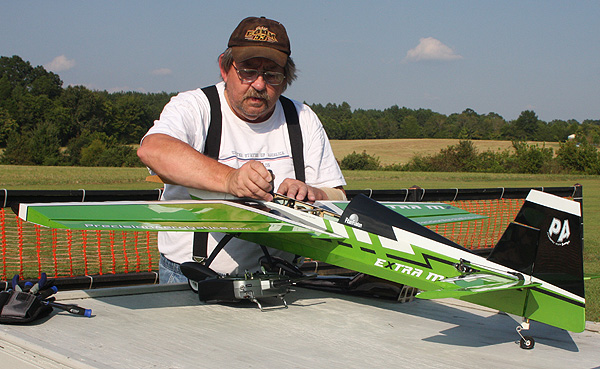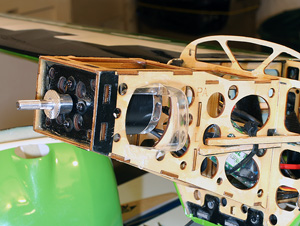



I normally like larger planes but this one flies "big" and is lots of fun in lighter winds.
Text, photos and video by Tom Hintz
Posted – 9-16-2013
It should be obvious by now that I am addicted to Precision Aerobatics airplanes. I’ve always liked the look of the Extra style of plane so their Extra MX was a natural for me, plus I wanted to add something a bit larger and faster to my personal air wing. I have been finding that the super-straight construction of Precision Aerobatics planes along with their lightweight and over the top power translates into predictable flight characteristics that make these planes easy and a bunch of fun to fly.
The Precision Aerobatics Extra MX has a wingspan of 58” (1,472mm), an overall length of just under 52” (1316.5mm) and an all up weight (including batteries) of 3.85-lb. (1750g / 61.7oz). That all means that the Precision Aerobatics Extra MX has 721 sq inch of wing area carrying just 12oz per square foot! I have heard 2.8 to 1 power to weight ratios and after flying the Precision Aerobatics Extra MX a bunch I can say that such claims could be a tad low. I have not found the upper limit of the vertical performance because we could not see it when it stopped climbing.
Through the use of their FiberFusion construction techniques that combine carbon fiber with balsa and lightweight plywood Precision Aerobatics uses jigs to build ultra-straight assemblies. The structure is engineered to be rigid and surprisingly strong, two important qualities in an airplane meant to be hammered around the sky. They even apply the covering and graphics as well as prepare all of the hinge locations and even install some of them for you. All of this pre assembly makes your construction go faster and get you to the flying field sooner.
Important things like the wings come pre fit to the fuselage and use pins to locate them exactly so the incidences are correct. You do have to install the horizontal stabilizer and align that visually to the wing tube but that is simple and goes quickly.
The Precision Aerobatics Extra MX comes with carbon fiber rod-type linkages and those are more than adequate and very light. I am hopelessly old school in that I want ball links everywhere and the zero play with adjust-ability they bring. That is just my preference, the carbon linkages are certainly strong enough as supplied.
I bought the package that includes all of the electronics. That includes the Precision Aerobatics (PA) Thrust 50 outrunner motor, PA Quantum 70A Pro ESC, four PA servos (ball bearings), high quality wire for extending the servo leads and the VOX 15x7 prop. I supplied my own LiPo packs (11.1V 2200mAh 20-40c). The Precision Aerobatics Extra MX uses two of those packs which is very cool for many of us that have other planes and helicopters using that super popular battery.

The motor box looks much weaker than
it really is.
You also get special carbon fiber control horns that get epoxied into the pre-cut slots in the control surfaces. These horns have only one hole but I have found the throw you get with that one position to be more than adequate. Once you get used to flying the Precision Aerobatics Extra MX (and other PA planes) you will grow to love all of the throw you can get to make use of the extensive low-speed capabilities.
I also got the “bling” package that includes a pair of very nice, padded wing bags, carbon fiber wheel pants and a carbon fiber spinner.
Because I fly off of grass exclusively I modified the wheel pants slightly so they would fit around my 3”-tall wheels. I also mounted the wheel pants slightly higher on the landing gear struts for a little more clearance. The Thrust 50 outrunner motor has plenty of power to jerk the Precision Aerobatics Extra MX out of the grass and into the air on takeoff with the included wheels but I like the larger wheels for how they smooth out landing in that same grass.
The maiden flight of my Precision Aerobatics Extra MX went very smoothly with just a bit of down elevator and one click or right aileron needed for hands-off straight and level flight at ¾ throttle. I pulled it to about a 45-degree angle, rolled it inverted and it gently increased the angle suggesting a CG that is a bit too far back. I added about ½-ounce of weight inside the cowl and repeated the test and the Precision Aerobatics Extra MX continued on the 45-degree angle at ¾ throttle with just a tick of climb showing me that the CG is where I like it, a tad farther back than normal. Add that CG to the large control surfaces with large throws and you get a hyperactive slow-mover that can fly high-speed patterns smoothly and precisely.
I began the second flight on my Precision Aerobatics Extra MX by just gassing it and after several feet of run pulled it up to vertical and let it go. The true vertical performance of the Precision Aerobatics Extra MX is limited only by your vision and courage. I literally let it go up out of sight once, cut the throttle and held it in a spin and we eventually found it in the sky again, not far from where it disappeared. I now limit show-off verticals to “high but in sight” but they still draw amazement from people who haven’t seen it before or would have never believed an electric plane could do that.
While 3D aerobatics are well within the Precision Aerobatics Extra MX envelope I am just learning them. I can say that this plane handles very well at walking speeds with just a little throttle influence now and then. Low inverted passes are simple because you can do them with full control at trotting speed. The Precision Aerobatics Extra MX is super steady at lower speeds as well as wide open.
You really get to see the result of all that super-straight jig building when you land the Precision Aerobatics Extra MX. With my CG back a little I have to gently bump the nose down but after that the Precision Aerobatics Extra MX all but lands itself. Even in the wind this plane lands easily usually with just a tick of throttle to counter the wind.
So far I have been limiting my flights to 6-minutes but the battery packs are taking under 1200 mAh during recharge so I could go longer. Keep in mind that I am doing lots of “on the gas” stuff in these flights so if you like floating it around some, your flight times could be longer.
The only in-flight correction I am working on is that in knife-edge flight the Precision Aerobatics Extra MX wants to push towards its belly a little. It is easy to control with a touch of up elevator but I am going to work on dialing in a couple degrees of up elevator in the mix and see if I can’t make knife-edge hands-off. Aside from that, the Precision Aerobatics Extra MX goes where you point it, will go there fast or slow and the controls work throughout the speed range which is substantial.
If you haven’t noticed yet, I love the Precision Aerobatics Extra MX. I can say without reservation that it is the cleanest flying airplane I have ever had under my control. It is super predictable, easy to land and it looks great the whole time. For carving lines in the sky I can’t see how it can be beat.
The folks at Precision Aerobatics really have got this FiberFusion construction figured out and they are engineering their planes right. It is an absolute dream to be able to put a plane together per the instructions and have it fly great right out off the bench. Foamies are nice, but the Precision Aerobatics Extra MX is way better in every way.
An important thing about the Precision Aerobatics Extra MX (and all Precision Aerobatics planes) is that you don't have to be an Ace team pilot to fly them. Team pilots can probably make a slightly overpowered table look good in the air. The Precision Aerobatics Extra MX is an easy plane to fly on low rates and makes a great vehicle for learning 3D or whatever aerobatics you want on high rates. Plus with today's radios you can slowly work your way up to the high rates on a learning curve that makes you comfortable. I love the Precision Aerobatics planes because you can tailor them to what you want or need to help you learn more advanced flying and they fly great all through that process.
The Precision Aerobatics Extra MX kit sells for $289.95 (9-16-2013). As shown in this review with all of the servos, motor, ESC, minus the batteries the package costs $658.95 but you literally need just the batteries!
See the Precision Aerobatics Extra MX page – Click Here
Have a comment on this review? - Email Me!